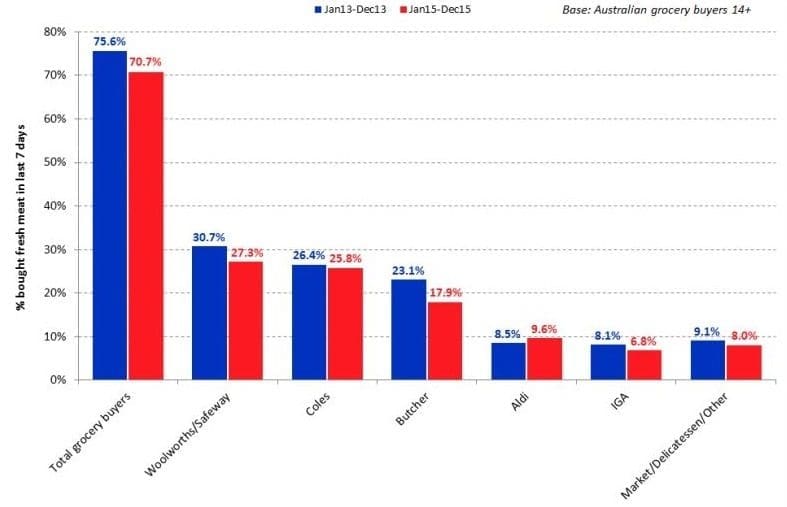ARE the days of the traditional independent butcher numbered?
Between January 2013 and December 2015, the proportion of Australian grocery buyers purchasing their fresh meat at their local butcher’s in any seven-day period fell from 23.1pc to 17.9pc, recent research findings released by consumer research firm Roy Morgan show.
Or is this decline simply due to a larger move away from buying fresh meat in general?
The research project revealed that the overall proportion of grocery buyers buying fresh meat anywhere has also fallen, from 75.6pc in 2013 to 70.7pc in 2015. The survey did not account for fresh meat consumed when eating out, via the food service channel.
Roy Morgan Research found that Aldi was the only supermarket group to have made any real gains in fresh meat sales over the last few years, with 9.6pc of grocery buyers 14+ purchasing their meat there in an average seven days, up from 8.5pc in 2013. That represents an additional 265,000 meat-shoppers each week.
Coles remained relatively stable, but Woolworths/Safeway, which declined from 30.7pc to 27.3pc, and IGA (down from 8.1pc to 6.8pc) experienced declines, as did markets/delicatessens (falling from 9.1pc to 8pc).
“There is no denying, however, that butchers have seen the most significant decrease in purchase incidence,” Roy Morgan Research said.
“And, unlike supermarkets or markets/delis, the buck stops with meat for butchers: they do not have the scope to adapt to changing grocery-buying habits with alternative products.”
Where Aussie grocery buyers purchase their fresh meat

Source: Roy Morgan Single Source (Australia), January-December 2013 (n=18,576) and January-December 2015 (n=15,367).
Despite the decline, butchers still hold a 23.5pc share of the total fresh-meat market, due to the relatively large amount their shoppers spend in an average seven days ($37). This is just ahead of the average fresh-meat spend for those grocery buyers who make their purchase at markets/delicatessens ($34), and considerably higher than supermarket-based purchases.
While Woolworth/Safeway accounts for a larger slice of the market (27.3pc), their fresh-meat customers spend substantially less (a weekly average of $27 per shopper); as do those who buy their meat at Coles ($25/23.2pc market share) and IGA/Foodland ($22/5.4pc market share). With its customers spending a weekly average of $22, ALDI’s dollar share of the fresh-meat market is currently 7.6pc.
Place of fresh-meat purchase by average weekly customer spend and market share

Source: Roy Morgan Single Source (Australia), January-December 2015 (n=15,367). Base: Australian grocery buyers 14+
Roy Morgan Research’s general manager of consumer products, Andrew Price, said Australian grocery buyers appeared to be gradually moving away from purchasing fresh meat, and butchers were the “most visible casualty.”
“At the moment, despite their shrinking customer base, butchers are retaining a decent share of the overall fresh-meat market due to the above-average amount spent by those grocery buyers who continue to shop with them. But unless they can stem (or reverse) the decline in shopper numbers, it seems inevitable that butchers’ market share will erode,” he said.
“The supermarket situation is a little different. The proportion of grocery buyers purchasing fresh meat is decreasing at a slower rate, and the customer volume is much higher. Whereas buying from a traditional butcher involves making a special trip, purchasing meat at the same time as the rest of a grocery shop is much simpler.
The news that Woolworths was changing the role of its staff butchers, bringing them to the front of store to sell pre-packaged meat and interact with customers rather than plying their trade out the back, indicated that the supermarket chain was endeavouring to pre-empt further declines, Mr Price said.
“But with the number of Australians who are ‘eating less red meat these days’ now surpassing 10.2 million people (increasing by 293,000 people since 2013), and the number of those pursuing a totally or almost vegetarian diet also rising over the same period, butchers and other players in the fresh meat market are facing challenging times,” he said.
“Knowing exactly who still buys fresh meat – from their demographics and attitudes to their shopping habits – is a good starting point, ensuring marketing communications are tailored to resonate with the right people.”
Source: Roy Morgan Research



HAVE YOUR SAY